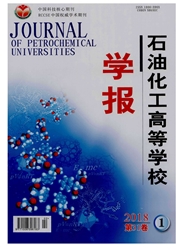

 中文摘要:
中文摘要:
利用质量分率电导率法测定了大港、中东、塔河常压渣油和它们相应的减压渣油的胶体稳定性,并从组分组成和组分性质探讨了渣油胶体稳定性影响因素。样品的胶体稳定性参数为1.45~8.20,差别较大。利用液相色谱法测定了各个渣油样品各组分的平均相对分子质量和平均偶极矩。关联了组分组成和组分极性与体系胶体稳定性的关系。结果表明,胶质与沥青质的含量之比越大,胶质与沥青质的极性越接近,体系的胶体稳定性越好;重芳香分含量越高、极性越接近沥青质的极性,体系的胶体稳定性越好;饱和分和轻芳烃组分含量越高、极性与沥青质极性差别越大,体系的胶体稳定性越差。
 英文摘要:
英文摘要:
The colloidal stability of several residues, including Da-gang (DG), Middle East (ME), Ta-he (TH) atmospheric residues, and the corresponding vacuum residues, were measured by the mass fraction normalized conductivity. In addtion, the polar or compositional characterization of fractions of samples was performed to elucidate their effect on colloidal stability. The colloidal stability paramters of samples were from 1.45 to 8.20. The mean molecular weight and the mean dipole moments of fractions were measured. The results show that fraction composition and the characteristics of them determined the colloidal stability of samples together and can be expressed by a formula. When the difference between dipole moment values of resins and asphaltenes is less, and the content ratio of resins to asphaltenes is bigger, the residue will be more stable. So do the heavy aromatics and asphaltenes. The ratio of saturates and light aromatics to asphaltenes is larger, the difference of polarity is larger, the sample will be more unstable.
 同期刊论文项目
同期刊论文项目
 同项目期刊论文
同项目期刊论文
 期刊信息
期刊信息
